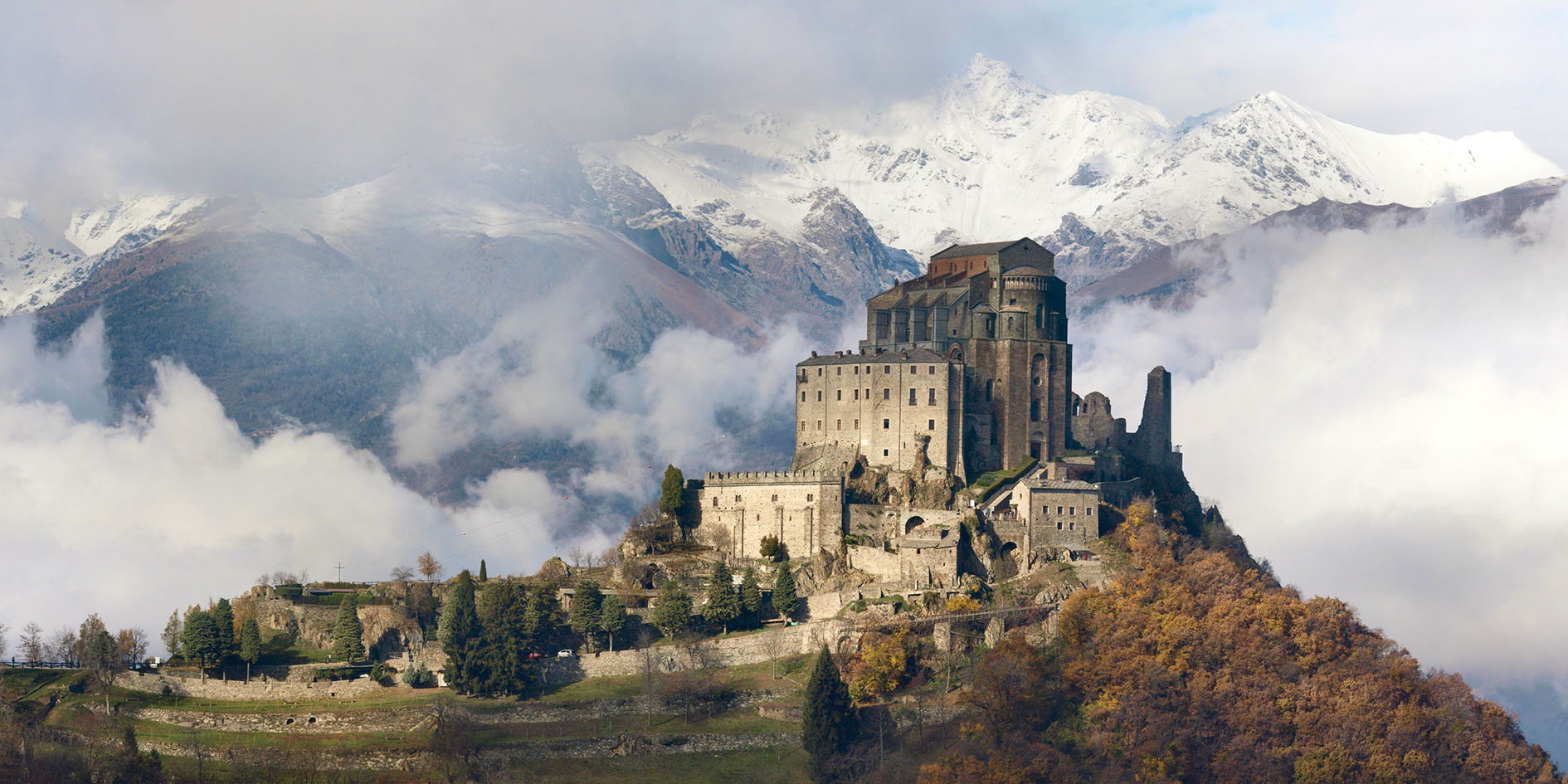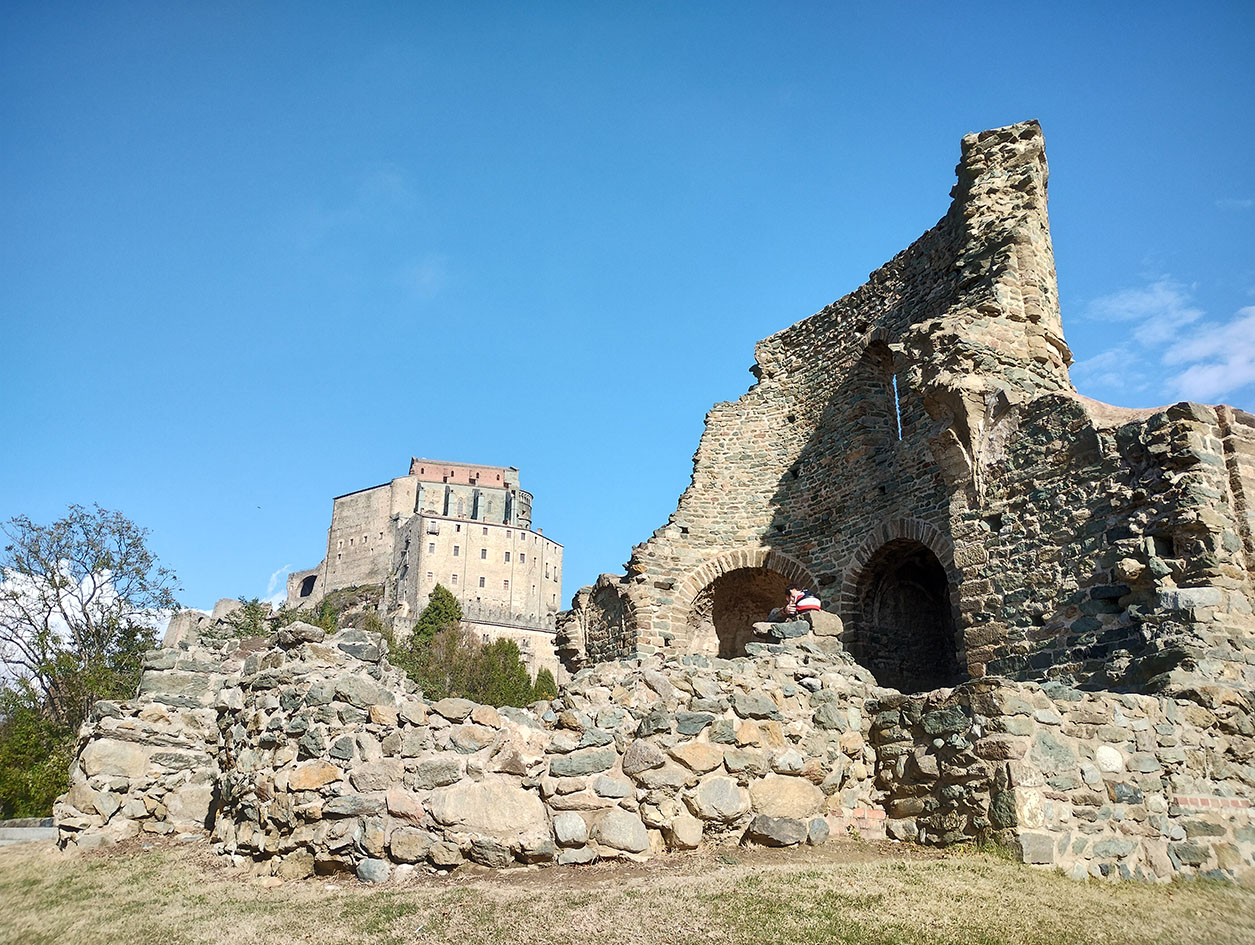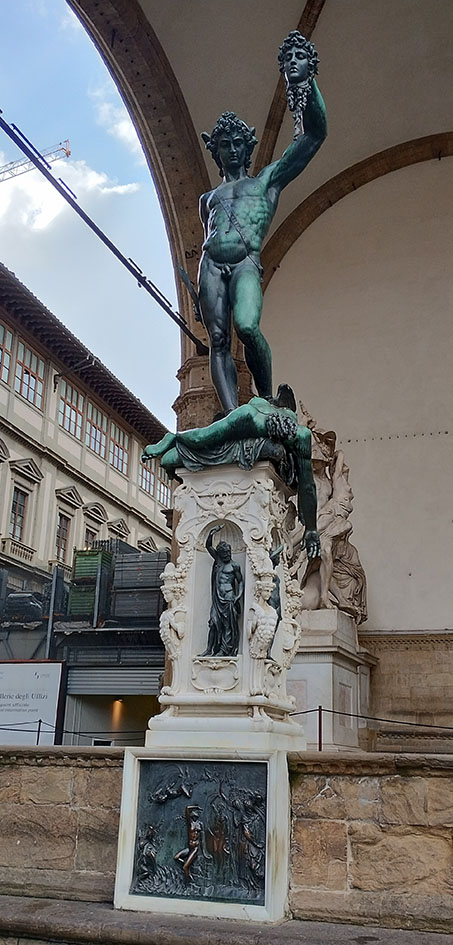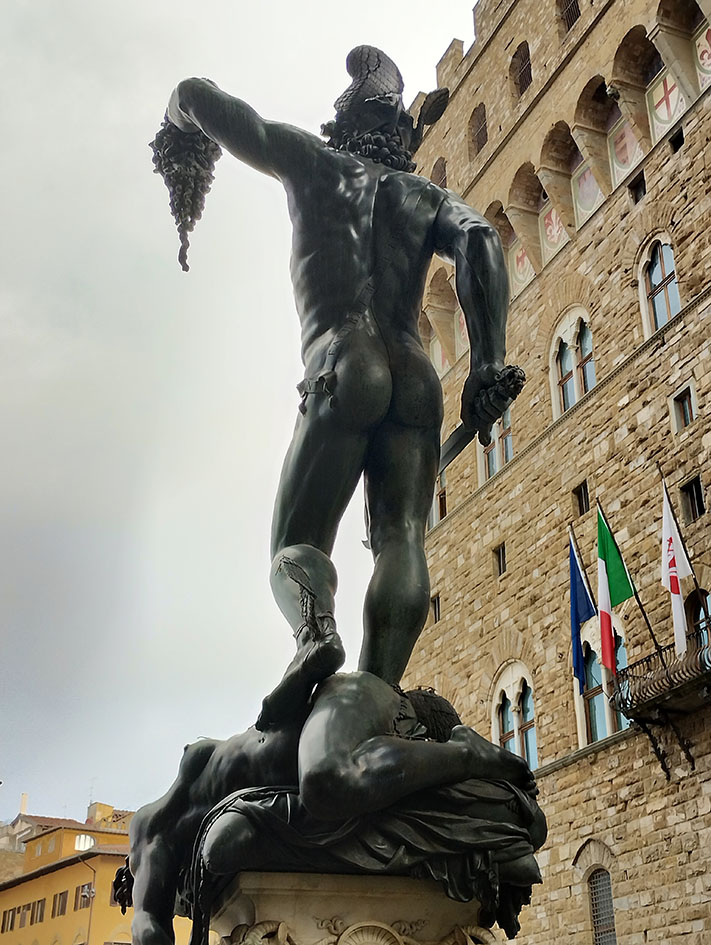Travel almost always has a double quality, that of being an experience of discovery as well as an encounter with the known. We venture into the unknown while retracing the paths that we already traveled in our minds. We contemplate the beauty of a monument, a sculpture or a building, while remembering how many times we have already visited it in novels, films, documentaries, history or art books, advertisements, family stories or in old posters. This has always happened to me, although on the last trip to Europe, visiting France and Italy, the reunion with the unknown occurred with unusual force, how could it not happen like this in these two countries? I share two of these experiences, both with loves born years before in reading.
From the Sant'Ambrogio train station, a few kilometers from Torino. Here begins our walk and ascent. In the distance you can see the Sacra di San Michele. Photograph by the author.
Taking advantage of the invitation of our French friend Josette to hold a concert and an exhibition of paintings in Paris, we visited some cities in Italy in November. In our first destination, Torino, we visited the Sacra di San Michele. The monastic architectural complex erected on the top of Mount Pirchiriano, at the foot of the Alps, although it dates back to the 10th century, it is known that its abbey was built by unifying a Romanesque chapel from the beginning of the 4th century and another Byzantine chapel from the 5th century. The slow Ascending the winding path that crosses the forest on the mountainside made the appearance of its more than a thousand-year-old architecture more spectacular.
Long ago, an important pilgrimage route passed along this steep path, linking Mont Saint-Michel in France with the Sanctuary of Saint Michael the Archangel, near Foggia. The three sacred places dedicated to Saint Michael are located about 1000 kilometers apart, aligned along a straight path, which ideally prolonged, leads to Jerusalem, on one side, and on the other to St Michael's Mount, in Cornwall (another place dedicated to St. Michael). Legend has it that that straight line is the imprint of Saint Michael's sword that reduced Lucifer, leaving him in his infernal destiny. La Sacra was the first of these discoveries as well as a literary reunion. I had lived in this abbey for years; He crossed its thick walls, walked through its temple, its courtyards and its forbidden library together with the friar William of Baskerville and his disciple Adso de Melk, characters in The Name of the Rose, by Umberto Eco, a work published in 1980. Indeed, this abbey inspired the Italian philosopher to write his brilliant novel. There - according to Eco's pen - a series of mysterious crimes took place, while between Franciscans and pontiffs the poverty or not of the Church was discussed. One of his characters, the blind librarian Jorge da Burgos, custodian of the abbey's library-labyrinth, was none other than our Jorge Luis Borges.
Detail of the very long staircase illuminated by the light that enters through the portal, baptized Staircase of the Dead or Stairway to Heaven. Note the construction built on the rock of the mountain itself, and the ancient wear on the steps. Photograph by the author.
Despite having started the journey early in the morning, it was already getting dark in the monastery. The climb up the hill was arduous, and we had to retrace the path as quickly as possible, so that the night and the cold in the forest would not surprise us. Once back in Turin, we returned to the attic that we rented, a room with a beautiful view of the entire Piedmontese city that was the capital of the kingdom of Italy. Outside this room, on the wall of the hallway, a neighbor had placed a small bookcase with the inscription Puoi prendere un libro, puoi lasciare un libro. Puoi fare l'uno o l'altro (“You can pick up a book, you can put down a book. You can do one or the other.”) Light on our luggage, we didn't have any books to leave, but I didn't hesitate to take one of those copies, L'isola del giorno prima, or in English “The Island of the Day Before,” another novel by Umberto Eco. I look at it here at the same time. next to me, while I write these memories of the trip, already in Buenos Aires.
The ruins of the monastery against the imposing Piedmontese landscape. Photograph by the author.
Finally, Cellini's Florence
After visiting -absolutely amazed!- Rome, we headed towards Florence. There we met up with Josette and another French friend, Dodó. We left the bags in our new home and began the passeggiata. Our first objective was the Piazza della Signoria, to meet there, in the Loggia della Signoria, with the sculpture Perseus with the head of Medusa by Benvenuto Cellini (Florence, 1500 - 1571). The Loggia della Signoria, also called Loggia dei Lanzi, is, without a doubt, the most important open-air sculpture complex in the entire West. Built between 1376 and 1382, the loggia served to shelter the numerous popular public assemblies and official ceremonies of the Florentine Republic. Beginning in the 16th century, with the creation of the Grand Duchy of Tuscany and the definitive suppression of republican institutions, this space was designated by order of Cosimo I de' Medici to house some masterpieces of sculpture, thus becoming one of the first exhibition spaces in the world.
View of the Loggia della Signoria, taken from the Palazzo Vecchio. Under the first arch on the left, Cellini's Perseus stands out. Photo by the author.
Two lions, works by the sculptors Flaminio Vacca (Caravaggio, 1538 - Rome, 1605) and Domenico Fancelli (Settignano, 1469 - Zaragoza, 1519), escort us up the stairs that lead to the large covered area but open to the square. Eleven sculptural groups are exhibited there; among them several Roman marbles, such as the Sabine ones, or Patroclus and Menelaus; The Abduction of the Sabine Women and Hercules and the Centaur Nesus, both by Giambologna (Douai, 1529 - Florence 1608); and The Abduction of Polixena, by Pio Fedi (Viterbo, 1815 - Florence, 1892). Thus, the Loggia results, the synthesis of the Florentine sculptural renaissance, that time in which anthropocentrism replaced theocentrism. Roman works, some of them copies of Greek originals (such as Patroclus and Menelaus), and original Renaissance sculptures inspired by those Greco-Latin myths and aesthetics. As an exception to the rule, the neoclassical sculpture of Pio Fedi, which although four centuries after the Renaissance, continues the Hellenic heritage. They are all beautiful sculptures carved in white marble, however one stands out for its height, the impressive figure it represents, and the intense green color of the bronze that constitutes it. This is Perseus with the Head of Medusa, by Benvenuto Cellini.
There, in Florence, capital of the Italian Renaissance, where more high-sounding names such as Leonardo, Botticelli, Michelangelo or Titian resonate, it is Cellini that catches me. Various readings fostered the irrepressible desire for a (re)encounter with his Perseus, and through his work, with his person. The first, that of my favorite Argentine novel, Bomarzo, by Manuel Mujica Láinez, published in 1962. Manucho writes that the young Prince Orsini was galloping along the beaches of his estate, his beaches, and he sees in the distance a man and a boy who They collected stones and shells on the seashore.
«They called me, waving their arms, and I approached. —Why don't you get off the horse? —the man asked. I, who feared that he would be too familiar and that he might abuse my defenseless weakness, mocking his companion for my hump, decided to tell him who I was, hoping that my name, which resonated with such a stately echo throughout Italy, would gain even more prestige. in that place, which like the adjacent area, for many leagues belonged to the Orsini, and which would reject any unpleasant idea. But the man did not flinch: "If you are Orsini," he replied haughtily, "I am Cellini, Benvenuto Cellini, goldsmith, and with these hands I can create such wonders in an hour that, even if you were the Emperor of Germany, you would treat me with deference and you would ask me to make you a crown, sure that you would not look anything like it.
(...)
I asked them what they were looking for on the shore.
"We are looking," Benvenuto answered me, "for some pebbles of strange shapes, because Nature is a subtle artist and invents with more inspiration than we do and is always showing us lessons of color and form. If you come down, you can help us look for them.
(...)
Cellini handed me something that sparkled.
"It's for you," he told me. Keep it in memory of this meeting.
It was a ring of pure steel, inlaid with gold.
"I did it," he added, "inspired by those that appear in urns full of ashes and that, according to what they say, are amulets that bring happiness."
Prince Orsini kept the ring as one of his most precious objects. They soon become friends, and in reading, I become friends of them.
He remembered the meeting of the prince and the artist while he observed, absorbed, 5.2 meters away, the freshly severed head held by Perseus. Stylized veins, viscera and blood hang from Medusa's neck, as do her body, contorted and stepped on by Perseus. The sculpture rests on a two-meter marble pedestal that contains on its sides four bronze figures, the parents and siblings of Perseus, that is, Zeus, Danae with Perseus as a child, Hermes and Athena. The Perseus is Cellini's masterpiece, made between 1545 and 1554, considered one of the masterpieces of Italian Mannerism, and the most famous and important of those exhibited in the Loggia della Signoria. It was commissioned in 1545 by Cosimo I after his inauguration as duke of the city, to be placed in the Piazza della Signoria next to Donatello's Judith and Michelangelo's David, as a reaffirmation of the power of the Medici family. The work represents the cut and end of the republican experience of the city, symbolized by the Medusa, from whose body come the snakes that represent the discords between citizens that had characterized the public life of the city, discords raised right there, in the Loggia . And of course, the duke himself represented in the Perseus.
The Perseus photographed from the Loggia, the Palazzo Vecchio can be seen behind it, and on the sides of the palace door, Michelangelo's David (the copy) and Hercules and Cacus by Baccio Bandinelli. Photograph by the author.
Years after Bomarzo I read My Life, the autobiography of Benvenuto Cellini. Written between 1538 and 1562, it was printed posthumously in 1728 under the title La Vita di Benvenuto di Maestro Giovanni Cellini fiorentino, scritta, per lui medesimo, in Firenze.
«-Duke Cosimo wants to know how much you ask for your Perseus.
I replied that even if the duke gave me ten thousand crowns he would not pay me enough, and that if I had imagined that we were going to reach such a situation I would never have stayed in Florence. That man, spiteful, spoke many insulting words to me and I said them to him too.
The next day, when I greeted the duke, he made signs to me and I approached him, who said angrily:
-With ten thousand ducats palaces and cities are made.
And I answered:
"Your excellency will find infinite men in this world who know how to make cities and palaces, but perhaps you will not find one who knows how to make a Perseus like mine."
How right Cellini was!, he thought, while he continued enjoying the transcendental beauty of this work. He also thought how notable the inspiration of this paragraph, overflowing with the artist's pride, was for Mujica Láinez, in the writing of the meeting between Cellini and Orsini that I cited above. Benvenuto captured his pride not only in the pages of his autobiography, it is also reflected in the great sculpture of him. His signature appears on the ribbon that surrounds Perseus' entire torso: BENVENVTVS CELLINVS CIVIS FACIEBAT MDLIII, that is, “the citizen Benvenuto Cellini did it in 1553.” But even more striking, the sculptor placed a self-portrait on the back of Perseus' head. The helmet forms the eyebrows, nose and shape of the face, while the hair on the back of Perseus' neck is Cellini's beard.
Each of the following days that we visited Florence I convinced my traveling companions so that the tours, which included the Palazzo Pitti or the Galleria degli Uffizi - and aperitifs from Campari or Aperol -, would intermediate or conclude at the Loggia della Signoria. Each new encounter with Perseus evoked another passage from his autobiography. Finally, we remembered his story of the moment of the casting of the great sculpture. Built using the lost wax process, Cellini sculpted the work in wax. It was then covered with clay and with heat this clay mold was poured of wax and fired. The mold - measuring three and a half meters long - was then placed in a pit on which a special oven was built. The bronze would be poured through many conduits, using a novel procedure, unique for this piece of strange and revolutionary proportions and shape for the date. The company was extremely arduous; about ten assistants worked alongside the teacher. At the same time that the metal began to melt, the oven had to be turned on with the hollow Perseus inside, so that the metal did not cool down in contact with the clay, and reached every corner of the work. A storm breaks out in Florence and the workshop starts to catch fire, at the same time Cellini boils with fever:
«[...] seized by intense fever and the flames of the workshop, a gale of rain lashing the mold and the oven, the bronze curdling due to sudden cooling, those present frightened and terrified, the semi-dying sculptor reviving the fire with logs of firewood and improving the metal in fusion with all his tin dishes and, as Marco says, between the fever, the delirium, the fire and the gale that raged in that tremendous night of artistic madness of a genius, a formidable thunder was heard, At the same time, a blinding flash of lightning dazzles the scene, the true fiat lux of that genesis of a statue, and that miracle of will creates a prodigy of high inspiration... Perseus was done.
On the Old Bridge, the monument to Benvenuto Cellini. Maestro gli orafi di Firenze (To Benvenuto Cellini. Master of the goldsmiths of Florence).



